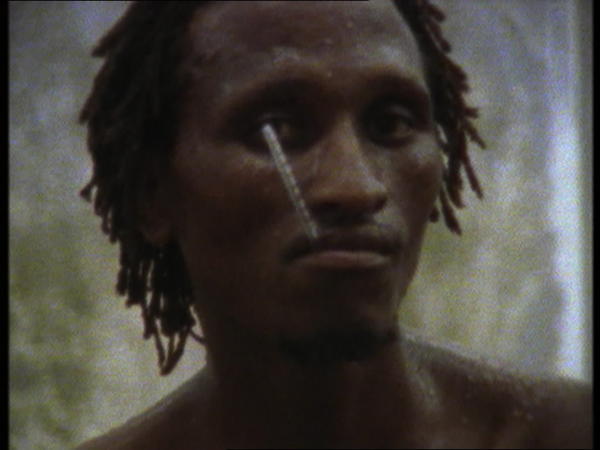On Image, Steve McQueen and Renegotiating our Relationships with the Dead
I’ve considered very much the business of curating family photo albums. It’s a messy affair. We consider, when framing an image, how that moment integrates into an ongoing narrative. A narrative often devoid of a reliable narrator. This isn’t to suggest that we are with the intent to manipulate, but it is to suggest that how we prioritize the representation of memory is predicated on a nostalgic sentimentality. Nostalgia operates as colors for which we use when painting the empty spaces of our memory. Each brush stroke, a sensation that we prescribe to a smile, a kiss or the tears swelling in the eye of an unknown pallbearer. If you’re Black and you’ve sifted through a family photographic album, you know the inevitable page turn to the photograph of the man, or woman, in a casket. Maybe you know them, and your relationship to them, or maybe you’re unaware of where they fit in the gumbo that is your Black folks. Regardless of whoever that person may have been, in life, in this visual compilation of your familial lineage, they are positioned in the same context as the living. Their contribution to memory is immortalized, just as your parents’ wedding or your nephews’ first birthday party. If I’m inquiring how that photograph arrived in its place, I’m asking what was the intent in curating the photographic album. And If I am directing that question at someone with the same face as I, then I am acknowledging our collective obsession with death. Death and the curation of our dead.
Photo: Steve McQueen
I will continue to use the term curation, given that there is an artistic language required to successfully narrate the history of man through still imagery. In the interview with Kass Benning, artist John Akomfrah comments on the morbidity of Black artistry, specifically film-making. “I think necrophilia is at the heart of black film-making. Not in the literal sense but in a postmodern sense in which people are invoking figures, there is an act of feeding off the dead….There is a kind of level morbidity which I think people have to realize in the quest for identity.It is a morbid business”. Whomever undertakes the task of curating a Black family photographic album is of the same obligation as the filmmaker and considers their responsibility to aesthetic. For the Black family photographic album curator, as Akomfrah may agree, it is the assumed responsibility to a digestible aesthetic, of the dead, for the consumption of the Black voyeur. We, as observers, are in effect voyeurs, when turning the pages of these photographic albums. We imagine the inner thoughts, and private lives, of the unknown faces in each photograph and all within the frame we imagine as a stage where these lives interact. Even if we, ourselves, are the subject, in the frame, we remain ignorant to the interior of other bodies surrounding our own. Thus, we apply stories to the faces, of others, and the process of memorializing concludes with an achieved sentimentality that allows us to accept the narrative, of the album, as a functioning record of our emotional histories. We do the same for our dead. We craft stories about whomever lay, embalmed, prepared for burial to fit into the puzzle of affections that are the surrounding images of the living. Often, their exploits are shrouded in mystery. The keys of discovery, of which, are locked behind the conscious of an unidentifiable source, generally our elders, who’d rather let unresolved matters of shame, guilt or frustration decompose with the corpse, of the dead, than find resolution. But, it matters not how the person died, nor how they lived, only that we must long for them, in death, in the same as we long for the memory of baby showers and family reunions. I do not mean that we wish for their presence, but our affections for their lived experience, even if we are absent this knowledge, must be merciful. We must be kind to our dead. This I agree, but am not without concern.
When looking at the work of British visual artist, Steve McQueen, there is a gentle, albeit brutal dissection of the present, informed by the past, most notably, his early installations which saw him attempt to memorialize, with moral rigor, African and African Diasporic bodies having been morphed by space-time. In a published collection of still frames, from McQueen’s installations, Carib’s Leap (2002) and Western Deep (2002), the former find’s McQueen, and long time cinematographer Sean Bobbitt, documenting the meanderings, labor and destitution of Grenadians along the shoreline of the same beach where, in 1652, Caribs, of Grenada, committed mass suicide. The act itself, of the Caribs throwing their bodies onto the rocks below what is now regarded as Carib’s Leap, has become historicized as a measure of defiance against the then French sponsored genocide of the indigenous Kalinago, or Carib population of Grenada. McQueen has little desire to curate memory here, instead inhabiting the station of witness. The history of atrocity is explicit and requires little from imagination. The dark bodies and faces are tethered to something historic and bear little room for one’s imprint of imagination. Jean Fisher, author of Imitations of the Real: On Western Deep and Caribs’ Leap, contends the point. “In Caribs’ Leap the Caribs are absent in actuality; and yet, we could say that they remain as a virtual past co-present, perhaps in the memory of an obscure image-thought floating in limbo until tricked into consciousness; or, as a displacement , in the way the African descendants re-inhabit the space-time of the island, doing what Caribs presumably always did when they weren’t being aggressed by colonialists - hanging out on the beach, attending to their boat’s, dying. Time passes, and yet is simultaneously strangely immobile.” And it is here, in the immobility of the unseen, as Fisher suggests, that McQueen reimagines the experience of nostalgia.
McQueen’s evocation of sentiment, and memory, is uncannily married to the origin of the word, nostalgia. Nostalgia finds its origin in two Greek root words, nostos and algos. Nostos translates to the English phrasing, returning home, and algos translates to the English term, pain. This is to suggest that McQueen’s narration of space-time, as a witness, requires a morally rigorous excavation of the historic and the prevailing legacies of trauma to procure the equitable memory of the viewer. For McQueen, the only way to establish a truth, especially of death, is to reveal the often disturbing components of that truth, in an effort to embrace the veracity of truths delecation’s. To discover a prevailing truth in that final act of the Carib’s, one must acknowledge that which led them to that cliff and the troubles which would befall their descendants, in order to properly, and justly, preserve the memory of their deliverance-in-death.
I am in no way indicting anyone for soliciting pleasure through the photographic image. I cherish the familial, and familiar, joy associated with exploring, from cover to cover, the family photographic albums stored away at my Grandparents’ South Carolina estate. I adore the images of my mother’s adolescence, my many cousins’ arrival to puberty and the discovery of relational details I hadn’t observed prior. I find myself engrossed with the motions, the positions of bodies embraced, the humourous posing in preparation for being immortalized by the lens. But inevitably, I’ll turn to find that body in a casket. It never summoned of me, inquiry about my relationship to lineage. The encounter is an unsettling one and not for the reason that I was in view of death. I remain disquieted, in fact, due to the image’s distance from death. There is rarely context and the body is an often ahistorical one. The remains are only that-remains. But death is something of reverence, fear and fetish for the sons and daughters of humanity's’ greatest injury-the Transatlantic Slave Trade. We are in a transgenerational tango with the grim reaper and it reflects in our lyric, our food, our sex, our delights and our sorrows. Thus, It would behoove us to renegotiate how we, familially, memorialize our dead. Addiction, abuse, brutality, disease, poverty, medical neglect and other harms have contributed to the demise of so many whose deaths are trivialized only to include the body in it’s burial state. What of the truth in their names or of their tales? We cannot honor the memory of the dead without unraveling the veil’s of our shame given the conditions of global Blackness. We are ashamed of our lineage, familially and historically. We loath succumbing to the condition of the victim, but as with the final act of the Caribs’, as Fisher describes, “Death here is liberation: a turn towards immortality through a return to a generative signifier, the ocean, which must have been as important to the sea-faring and fishing Caribs’ as it was to the later African survivors of the Middle Passage.” The stories of our dead may not read as melancholically robust, or worth some triumphant mourning song, but they are knitted into the same fabric as any other story of the Black body in death. A sole Polaroid image, of a body, embalmed, is mere erasure of the unseen. I do not suggest capturing, in documentary form, the precise details of the every day, but if we are to appropriately memorialize our dead, we must consider the intent for which we memorialize, and document, their lived experiences. All that isn’t seen in the pages of our photographic albums, pictures along our walls or spoken with their names on our lips. If we do not, their deaths remain hollow and our narrative; disempowered. As McQueen suggested, responding to an inquiry about the agitation of Black audiences towards the production of 12 Years a Slave, during an interview at the Walker Art Center, “In order for one to go forward, we must embrace that shame and master it, in order to move on, just as other groups have done within their unfortunate pasts. It’s a must.” McQueen's appeal, I do concur. We are storytellers, only our tales serve as archive of, as we know but may not admit, great horror. To neglect any detail is to maim our histories and to be complicit in assuring we amount to solely decaying bone and tissue. That, more than mastering the memories of our deceased, is damning the dead.



